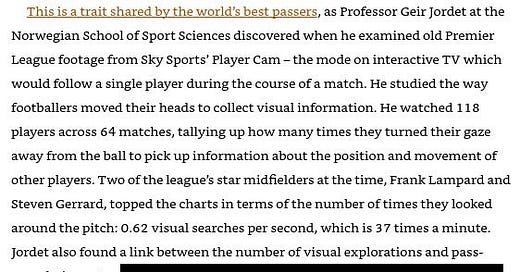Xavi is making a point well accepted in soccer: to be a great midfielder you need to know what you are going to do with the ball before you get the ball. In order to do that you need to know where everyone is on the field, so you need to look around.
OK - but that’s football. If you don’t make a decision quickly someone will take the ball away from you. In ultimate you get 10 seconds with no threat to figure out what to do with the disc. So it’s not essential, and indeed getting players to slow down and relax a little bit after catching the disc is often the first step you need to take.
However it’s only really an advantage to take a lot of time against pure 1v1 defence (and not always then), or when you need to calm your offence down.
That doesn’t mean scanning the field is not something you should be doing on offence as an ultimate player. Two key reasons you should start doing this more:
a) A really good defence is likely to be better once they are set - particularly any type of team defence - so attacking it quickly off a completed pass is going to be more beneficial. To do that you’ll need to understand where everyone on the field is.
b) You’ll also see major benefits as cutters - more coordination and spread out attack patterns if you actually know where everyone is.
Examples
OK - watch this clip. How many times does (a) a cutter look behind them vs. (b) how many times does a cutter run into occupied space. No forward passes here result in another forward pass.
Answers in the comments below.
This isn’t a criticism of Clapham - I literally clicked into a random recent game and this was the first point I watched. You could take this approach to any game and see much the same thing - players do not look around them. They might look in front of them, some will even look left or right, barely any will ever look fully around them*.
To contrast, check out this clip of Japan from the WUGC open final in 2016. You can clearly see the cutters all scanning across the line of cutters as the disc moves - not all hard focused on the disc. The result is a fast, coordinated attack that is exactly what the US must have prepared for but happens too fast to stop.
Lessons
Scanning the field is helpful to the offence, but we don’t see it very often because ultimate is generally taught in a way that particularly discourages the habit from forming. Part of that is just the nature of the game - you have 10 seconds to throw the disc so you can survive without looking around - it’s enough time for multiple cuts so someone will likely get free at some stage. As coaches, we can’t really change that.
But there are two other major contributors to this that are controllable:
a) Single use offence patterns
A lot of offence teaching in my experience has been to introduce one pattern and one reset and that’s basically that. Just keep cycling between those things and don’t think too much about all the other options you could take. I understand the urge to get a functional offence together asap, particularly coaching new players, because ultimate can be a frustrating game otherwise. However, I’m very much anti-stacks (or anti-patterns) for beginners because I’d prefer to have them explore the whole field.
b) Rigid practice techniques
If your practices are based on drills where players are told what the options are and where they should look then it’s unlikely that they’ll develop the habit of looking around. Without the rigid structure of a drill to guide them offence degenerates into a mess of players running into the same spaces. So instead: train in a way that replicates gameplay and encourage players to look around.
As a sidenote here - I used to get very excited when the particular pattern we’d be drilling at training came out in a game. ‘Look’ I’d think ‘our training must be great because that’s exactly what we’d practiced’. It was after a few years of this that I started to realise that if something was only happening the way we practiced it once or twice a game that maybe I wasn’t really preparing people for the actual game…
*Laffi does in the next point (spoilers)






Nice! I've written a somewhat similar article: https://someflow.substack.com/p/oodles-of-oodas